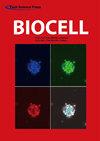灰槭全基因组调查及其多态简单序列重复序列的开发与应用
IF 1
4区 生物学
Q4 BIOLOGY
引用次数: 0
摘要
背景:灰槭(Acer griseum Pax)是中国特有的濒危树种,具有观赏价值和经济价值。然而,缺乏关于其基因组大小和特征的信息阻碍了在基因组水平上的进一步工作。方法:本文应用生物信息学方法预测的特点和模式a griseum基因组,提供制定其全基因组测序计划的一个重要依据。本研究还对灰菊的简单重复序列(SSRs)进行了鉴定,为全基因组SSR标记的开发和应用奠定了基础。在这项研究中,PE150测序是由华大基因研究院MGISEQ平台,和序列文件被K-mer分析方法估计GCE软件的特征信息。结果:最终确定的基因组大小为739.63 Mb,杂合率为1.33%,重复率为65.68%。在组装的基因组序列中,共鉴定出825960个SSR位点,成功设计引物526020个位点。为了验证引物的有效性,我们随机选取100对引物进行合成,其中81对引物成功扩增出目标片段。选取14对多态性较好的引物对两个居群的31个灰霉病人个体进行主成分分析,显示出良好的杂合度和PIC值。根据这些发现,这些SSRs可能识别基于地理区域的基因变异。结论:全基因组杂合率高,重复率高,建议采用Illumina + PacBio组装策略进行全基因组测序。此外,本研究批量设计的SSR引物为深入研究灰黄的种群结构和种群维持机制奠定了基础,有助于有效保护和可持续利用灰黄种质资源。本文章由计算机程序翻译,如有差异,请以英文原文为准。
The whole-genome survey of Acer griseum, its polymorphic simple sequence repeats development and application
Background: Acer griseum Pax is an endangered species endemic to China with both ornamental and economic value. However, the lack of information on its genome size and characteristics hinders further work at the genome level. Methods: This paper applied bioinformatics methods to predict the characteristics and patterns of the A. griseum genome, providing an important basis for formulating its whole-genome sequencing scheme. This study also characterized the simple sequence repeats (SSRs) of A. griseum, laying the foundation for the development and application of genome-wide SSR markers. In this study, PE150 sequencing was performed by the BGI MGISEQ platform, and the sequence files were analyzed by the K-mer method to estimate the characteristic information by GCE software. Results: The genome size was finally determined to be 739.63 Mb, its heterozygosity ratio was 1.33%, and the repetition ratio was 65.68%. A total of 825,960 SSR loci were identified in the assembled genome sequence, and primers were successfully designed for 526,020 loci. To verify the effectiveness of these primers, 100 pairs of primers were randomly selected and synthesized, and 81 pairs successfully amplified the target fragments. Fourteen pairs of primers with good polymorphism were selected for principal component analysis of 31 A. griseum individuals from two populations, showing favorable heterozygosity and PIC values. According to the findings, these SSRs might identify genetic variations based on geographic areas. Conclusion: It is suggested that Illumina + PacBio assembly strategy should be used for whole-genome sequencing due to the high heterozygosity rate and high repetition rate of the genome. In addition, the SSR primers designed in batches in this study laid a foundation for the in-depth study of population structure and population maintenance mechanism of A. griseum, which is helpful for the effective conservation and sustainable utilization of this germplasm resource.
求助全文
通过发布文献求助,成功后即可免费获取论文全文。
去求助
来源期刊

Biocell
生物-生物学
CiteScore
1.50
自引率
16.70%
发文量
259
审稿时长
>12 weeks
期刊介绍:
BIOCELL welcomes Research articles and Review papers on structure, function and macromolecular organization of cells and cell components, focusing on cellular dynamics, motility and differentiation, particularly if related to cellular biochemistry, molecular biology, immunology, neurobiology, and on the suborganismal and organismal aspects of Vertebrate Reproduction and Development, Invertebrate Biology and Plant Biology.
 求助内容:
求助内容: 应助结果提醒方式:
应助结果提醒方式:


